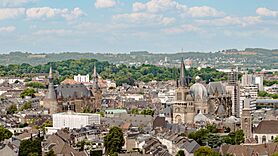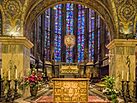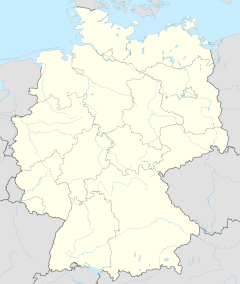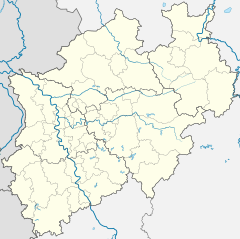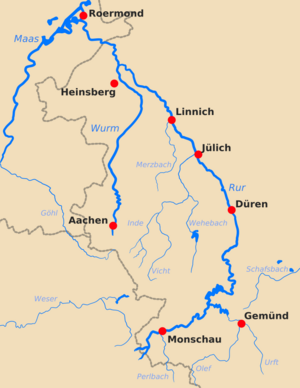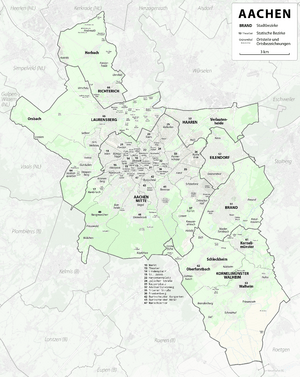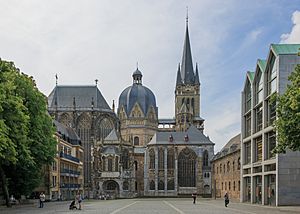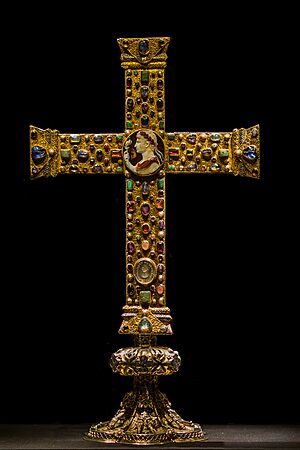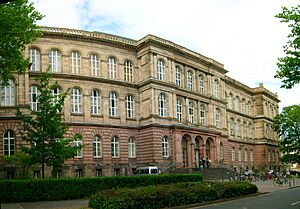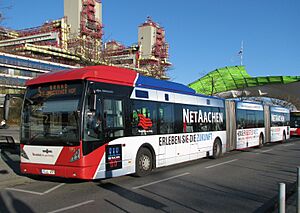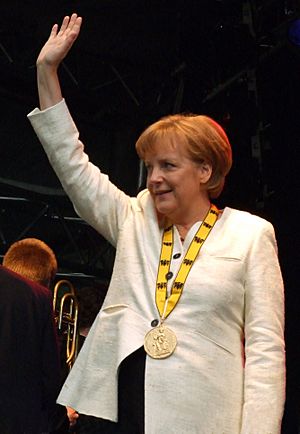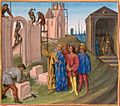Aachen facts for kids
Aachen (pronounced AH-kən) is a historic city in Germany, located in the state of North Rhine-Westphalia. It's the westernmost large city in Germany, right on the border with Belgium and the Netherlands. About 261,000 people live here.
Aachen is famous for its warm natural springs, which have attracted people for thousands of years. It was once a very important city in the Middle Ages, especially because of Charlemagne, a famous emperor who made Aachen his main home. Today, Aachen is known for its excellent university, the RWTH Aachen University, which is a leader in technology and engineering.
The city is also known for its delicious gingerbread, called Aachener Printen, and its lively carnival celebrations.
Quick facts for kids
Aachen
Oche (Aachen dialect)
|
|||
|---|---|---|---|
|
View over Aachen with the town hall and the cathedral
Aachen Cathedral and St. Foillan's Church
Choir and apse with Shrine of Mary
Octagon of the Palatine Chapel
Shrine of Charlemagne
Bust of Charlemagne
Elise's Fountain
St. John's Church
|
|||
|
|||
|
Location of Aachen within Städteregion Aachen
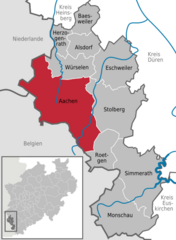 |
|||
| Country | Germany | ||
| State | North Rhine-Westphalia | ||
| Admin. region | Cologne | ||
| District | Aachen | ||
| Area | |||
| • Total | 160.85 km2 (62.10 sq mi) | ||
| Elevation | 173 m (568 ft) | ||
| Population
(2022-12-31)
|
|||
| • Total | 252,136 | ||
| • Density | 1,567.52/km2 (4,059.86/sq mi) | ||
| Time zone | UTC+01:00 (CET) | ||
| • Summer (DST) | UTC+02:00 (CEST) | ||
| Postal codes |
52062–52080
|
||
| Dialling codes | 0241 / 02405 / 02407 / 02408 | ||
| Vehicle registration | AC / MON | ||
Contents
What's in a Name? The Meaning of Aachen
The name Aachen comes from an old German word for "water" or "stream." This makes sense because the city has many warm natural springs. Even the old Roman name for the city, Aquae Granni, meant "waters of Grannus." Grannus was a Celtic god of healing, worshipped at these springs.
Over time, the name changed in different languages. For example, in French, it became Aix-la-Chapelle, which means "Aix of the chapel." This name was used to tell it apart from another city called Aix, and it refers to the famous chapel built by Charlemagne.
Here are some other names for Aachen in different languages:
| Language | Name | Pronunciation in IPA |
|---|---|---|
| Aachen dialect | Oche | [ˈɔːxə] |
| Catalan | Aquisgrà | [əkizˈɣɾa], [akizˈɣɾa] |
| Czech | Cáchy | [ˈtsaːxɪ] |
| Dutch / Low German | Aken | [ˈaːkə(n)] |
| French | Aix-la-Chapelle | [ɛks la ʃapɛl] |
| Greek | Ακυίσγρανον (Akyísgranon) | [aciˈizɣranon] |
| Italian | Aquisgrana | [akwizˈɡraːna] |
| Latin | Aquisgrana, Aquae Granni, Aquis Granum | |
| Limburgish | Aoke | [ˈɔːkə] |
| Luxembourgish | Oochen | [ˈoːχən] |
| Polish | Akwizgran | [aˈkfizɡran] |
| Portuguese | Aquisgrano, Aquisgrão | European Portuguese: [ɐkiʒˈɣɾɐnu], [ɐkiʒˈɣɾɐ̃w] |
| Russian | Ахен (Akhen) | [ˈɐxʲɪn] |
| Spanish | Aquisgrán | [akisˈɣɾan] |
| Walloon | Åxhe | [ɑːç] |
Aachen's Long History
Aachen has been a home for people for a very long time. Stone tools found here show that people lived near the warm springs about 5,000 years ago. Later, Celtic people settled here, drawn by the healing waters.
Roman Times and Early Settlements
Around the 1st century AD, the Romans built a large spa town called Aquae Granni. They channeled the hot springs into bathhouses and built a temple. After the Romans left around 375 AD, the Franks took over the town.
Charlemagne's Capital
Aachen became super important in the 8th century. Pepin the Short, a Frankish king, built a castle here. His son, Charlemagne, loved Aachen and made it his main royal home. He spent most of his winters here from 792 until he died in 814.
Charlemagne built a magnificent chapel and a palace in Aachen. Because of him, Aachen is sometimes called the "cradle of Europe." After Charlemagne died, he was buried in the chapel he built.
A City of Coronations
For over 500 years, from 936 to 1531, Aachen was the place where many German kings and queens were crowned. Thirty German kings and twelve queens were crowned in Charlemagne's chapel, which later became the Aachen Cathedral. This made Aachen a very special and important city in the Holy Roman Empire.
Over time, Aachen became less powerful. It suffered from wars and a big fire in 1656 that destroyed much of the city. Many buildings were rebuilt in the beautiful Baroque style.
Modern Times and World Wars
In 1794, the French army took over Aachen. Later, in 1815, it became part of Prussia (which was a part of Germany). In the 19th century, Aachen grew with factories and railways. It became known for making things like railway parts, needles, and wool products.
During World War II, Aachen was heavily damaged by bombing and fighting. It was the first German city captured by the Western Allies in 1944. Many buildings were destroyed, but the famous Aachen Cathedral was mostly saved.
After the war, Aachen was rebuilt. Today, it's a modern city with a strong focus on technology and education, thanks to its university.
Where is Aachen?
Aachen is located in a special spot where Germany, the Netherlands, and Belgium meet. The Dutch town of Vaals is only about 6 kilometers (3.7 miles) away. The city sits near the Wurm River, which flows into the larger Meuse River system.
Aachen is also close to the High Fens and the Eifel Mountains. The highest point in Aachen is 410 meters (1,345 feet) above sea level, and the lowest is 125 meters (410 feet).
Aachen's Climate
Aachen has a mild climate with humid weather, gentle winters, and warm summers. It gets more rain than some other German cities because of its location near the Eifel mountains. Sometimes, special winds called Foehn winds can make the air warmer.
The average temperature in January is about 3.2°C (37.8°F), and in July, it's about 18.7°C (65.7°F). It rains fairly evenly throughout the year.
| Climate data for Aachen (1991–2020 normals, extremes 1891–present ) | |||||||||||||
|---|---|---|---|---|---|---|---|---|---|---|---|---|---|
| Month | Jan | Feb | Mar | Apr | May | Jun | Jul | Aug | Sep | Oct | Nov | Dec | Year |
| Record high °C (°F) | 16.2 (61.2) |
20.5 (68.9) |
24.5 (76.1) |
30.0 (86.0) |
34.2 (93.6) |
36.6 (97.9) |
38.6 (101.5) |
37.2 (99.0) |
34.3 (93.7) |
26.9 (80.4) |
22.1 (71.8) |
17.6 (63.7) |
38.6 (101.5) |
| Mean daily maximum °C (°F) | 5.7 (42.3) |
6.8 (44.2) |
10.6 (51.1) |
14.7 (58.5) |
18.5 (65.3) |
21.4 (70.5) |
23.7 (74.7) |
23.3 (73.9) |
19.4 (66.9) |
14.8 (58.6) |
9.4 (48.9) |
5.6 (42.1) |
14.5 (58.1) |
| Daily mean °C (°F) | 3.2 (37.8) |
3.8 (38.8) |
6.6 (43.9) |
10.0 (50.0) |
13.8 (56.8) |
16.6 (61.9) |
18.7 (65.7) |
18.3 (64.9) |
14.8 (58.6) |
10.8 (51.4) |
6.7 (44.1) |
3.3 (37.9) |
10.5 (50.9) |
| Mean daily minimum °C (°F) | 0.8 (33.4) |
1.2 (34.2) |
3.4 (38.1) |
5.8 (42.4) |
9.3 (48.7) |
12.0 (53.6) |
14.4 (57.9) |
14.0 (57.2) |
11.2 (52.2) |
7.7 (45.9) |
4.4 (39.9) |
1.2 (34.2) |
7.1 (44.8) |
| Record low °C (°F) | −20.4 (−4.7) |
−20.2 (−4.4) |
−11.9 (10.6) |
−4.8 (23.4) |
−1.3 (29.7) |
1.8 (35.2) |
5.8 (42.4) |
3.4 (38.1) |
0.0 (32.0) |
−5.7 (21.7) |
−8.9 (16.0) |
−16.5 (2.3) |
−20.4 (−4.7) |
| Average precipitation mm (inches) | 64.3 (2.53) |
63.4 (2.50) |
59.3 (2.33) |
53.5 (2.11) |
65.0 (2.56) |
70.0 (2.76) |
79.0 (3.11) |
80.6 (3.17) |
68.1 (2.68) |
66.1 (2.60) |
66.6 (2.62) |
74.4 (2.93) |
811.4 (31.94) |
| Average precipitation days (≥ 0.1 mm) | 17.0 | 16.5 | 16.4 | 13.5 | 15.9 | 14.6 | 15.3 | 14.4 | 14.1 | 15.1 | 18.2 | 18.2 | 189.6 |
| Average snowy days (≥ 1.0 cm) | 5.5 | 5.1 | 1.2 | 0.1 | 0 | 0 | 0 | 0 | 0 | 0 | 1.1 | 3.8 | 17.1 |
| Average relative humidity (%) | 82.1 | 80.1 | 74.9 | 68.9 | 70.3 | 70.5 | 70.7 | 72.1 | 77.4 | 80.7 | 83.7 | 84.8 | 76.4 |
| Mean monthly sunshine hours | 68.3 | 75.0 | 126.2 | 168.7 | 194.9 | 207.9 | 208.1 | 196.9 | 151.3 | 121.5 | 68.0 | 52.5 | 1,634.3 |
| Source 1: NOAA | |||||||||||||
| Source 2: Data derived from Deutscher Wetterdienst | |||||||||||||
Rocks and Springs
Aachen's ground is made of different types of rocks, some as old as the Devonian period. These rocks were folded and pushed up long ago, creating the hills around the city. Later, during the Cretaceous period, the ocean covered this area, leaving behind clay, sand, and chalk.
There are more than 30 warm thermal springs in Aachen and the nearby area of Burtscheid. These springs are why people have been attracted to Aachen for thousands of years. The area also has active fault lines, which can cause earthquakes sometimes.
People of Aachen
Aachen has about 245,000 residents. Many people from other countries live here, especially students who come to study at the university.
| Nationality | Population (2022) |
|---|---|
| 6,140 | |
| 3,225 | |
| 2,791 | |
| 2,583 | |
| 2,175 | |
| 2,025 | |
| 1,879 | |
| 1,836 | |
| 1,681 | |
| 1,543 | |
| 1,436 |
| Year | Population |
|---|---|
| 1994 | 246,570 |
| 2007 | 247,740 |
| 2011 | 238,665 |
| 2014 | 243,336 |
| 2015 | 245,885 |
Local Dialect
The local dialect spoken in Aachen is called Öcher Platt. It's a special kind of German that has some influences from the Dutch language because of Aachen's location near the Netherlands.
Parts of the City
Aachen is divided into seven main areas, called boroughs. Each borough has its own local council. These boroughs are further split into smaller sections for statistics.
The main boroughs of Aachen are:
- Aachen-Mitte (Central Aachen)
- Brand
- Eilendorf
- Haaren
- Kornelimünster/Walheim
- Laurensberg
- Richterich
Neighboring Towns
Aachen shares its borders with several other towns and cities. These include Herzogenrath, Würselen, Eschweiler, Stolberg, and Roetgen in Germany. It also borders Raeren, Kelmis, and Plombières in Belgium, and Vaals, Gulpen-Wittem, Simpelveld, Heerlen, and Kerkrade in the Netherlands.
Famous Places to See
Aachen Cathedral
The Aachen Cathedral is the most famous building in the city. It was built by Charlemagne starting around 796 AD and was one of the largest cathedrals north of the Alps at the time. It was inspired by a church in Italy.
Charlemagne was buried here, and his remains are still kept in the cathedral. For 600 years, from 936 to 1531, it was the place where German kings and queens were crowned. The cathedral has been changed and added to over many centuries, so it shows a mix of different building styles. It is now a UNESCO World Heritage Site.
Cathedral Treasury
The Aachen Cathedral Treasury holds a collection of very old and valuable religious objects. Some people believe Charlemagne himself started this collection. Over the centuries, many important items were added, often as gifts from emperors and kings. These items show the rich history of the cathedral and its connection to European rulers.
Aachen Town Hall
The Aachen Rathaus (Town Hall) was built in 1330. It stands between two main squares in the city. Inside, you can see beautiful paintings by Alfred Rethel that tell stories from Charlemagne's life. Replicas of the Imperial Regalia (royal symbols) are also kept here.
The Town Hall is still used today by the mayor and city council. It's also where the important Charlemagne Prize is given out each year.
Other Interesting Sights
- The Grashaus is one of the oldest non-religious buildings in central Aachen. It used to be the city hall.
- The Elisenbrunnen is a beautiful building over one of Aachen's famous warm springs. You can even drink the spring water there!
- You can still see parts of the old medieval city walls and two of its original gates, the Ponttor and the Marschiertor.
- The St. Michael's Church, Aachen is a beautiful Baroque church built in 1628. Today, it is a Greek Orthodox church and is also used for concerts.
- The synagogue in Aachen was destroyed in 1938 but was rebuilt and reopened in 1995.
- The Suermondt-Ludwig Museum has a great collection of art and sculptures.
-
Carolus Thermen, thermal baths named after Charlemagne
Aachen's Economy
Aachen is an important center for industry and technology. It used to be known for coal mining and textiles. Today, it produces electrical goods, food (like chocolate!), glass, and metal products. Many companies in Aachen work with science, engineering, and information technology.
Electric Vehicles
Aachen has become a hub for making electric vehicles. Companies like StreetScooter and e.GO Mobile started here, developing and producing electric vans and cars. StreetScooter, for example, makes electric delivery vans for DHL.
Culture and Fun

- Aachen was one of the first cities in the world to put the year (like 1372) on its coins.
- The Scotch Club in Aachen was the first discothèque (dance club) in Germany, opening in 1959.
- The city is famous for its Aachener Printen, a type of gingerbread. It's different from regular gingerbread because it uses sugar syrup instead of honey.
- Aachen is a major center for carnival celebrations in Germany, with colorful parades and costumes.
Learning in Aachen
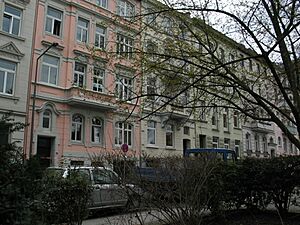
Aachen is home to several important schools and universities:
- RWTH Aachen University: This is one of Germany's top universities for technology. It's especially known for engineering, computer science, and physics. Its university hospital, Uniklinikum Aachen, is the largest single-building hospital in Europe.
- FH Aachen: This is a university of applied sciences, offering practical engineering education. Many international students study here.
- Katholische Hochschule Nordrhein-Westfalen: This Catholic university offers programs in social work, education, and nursing.
- The Hochschule für Musik und Tanz Köln (Cologne University of Music) has a campus in Aachen, focusing on opera and musical theater.
The German army also has a technical school in Aachen.
Sports in Aachen
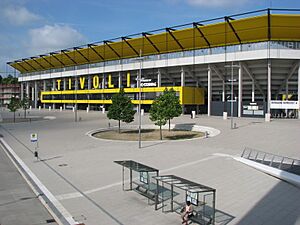
- The annual CHIO Aachen is the biggest horse riding event in the world. It's like the Wimbledon of equestrian sports! Aachen hosted the 2006 FEI World Equestrian Games.
- The local football (soccer) team is Alemannia Aachen. They play their home games at the "New Tivoli" stadium, which can hold over 32,000 fans.
- The "Ladies in Black" are Aachen's women's volleyball team, playing in Germany's top league.
Getting Around Aachen
Trains
Aachen's main train station, the Hauptbahnhof, connects the city to major places like Cologne, Brussels, and Frankfurt. High-speed trains like ICE and Eurostar also stop here. There are also smaller stations within the city.
Buses
Aachen has a large bus network that covers the city and even goes into Belgium and the Netherlands. The ASEAG company operates most of the bus routes.
Roads
Aachen is connected to major highways (Autobahns) like the A4 and A44, making it easy to travel by car.
Airport
The main airport for Aachen is Maastricht Aachen Airport, located about 15 nautical miles (28 km) northwest of the city. There's also a smaller airfield for private planes called Aachen Merzbrück Airfield.
Charlemagne Prize
Since 1950, a special award called the Charlemagne Prize (Karlspreis) has been given out in Aachen every year. It honors people who have done great things to help unite Europe. It's usually awarded at the City Hall. Famous winners include Pope Francis and former US President Bill Clinton.
See Also
 In Spanish: Aquisgrán para niños
In Spanish: Aquisgrán para niños
Images for kids
-
Construction of Aix-la-Chapelle, by Jean Fouquet
-
The siege of Aachen by the Spanish Army of Flanders under Ambrogio Spinola in 1614
-
View of the Old Synagogue after its destruction on Kristallnacht, November 1938
-
Ford Research Center, Aachen
Twin Towns
Aachen is connected to these cities around the world:
Former Twin Town


